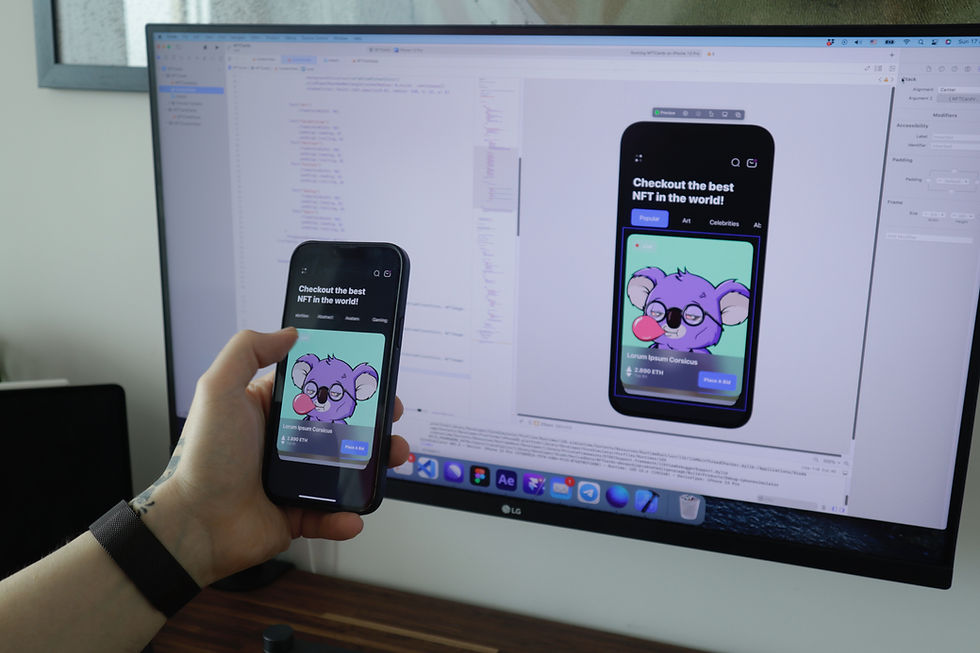Top security concerns for Android developers and how to address them
- Apr 10, 2023
- 4 min read

Introduction
Android app development has become one of the most popular fields in the tech industry. With its popularity, comes the need to ensure security in Android apps. Security is one of the most important aspects of app development, as any vulnerability in the app can compromise user data and cause other serious problems.
In this blog post, we will cover the top security concerns for Android developers and how to address them.
Secure Coding Practices
Secure coding practices are essential to building a secure Android application.
Avoid Hardcoding Sensitive Data
Sensitive data like passwords or API keys should never be hardcoded in your app's code. Instead, they should be stored in a secure location like Android's KeyStore or in a configuration file.
// Avoid hardcoding sensitive data in code
val apiKey = BuildConfig.API_KEY
Use Kotlin Safe Calls
Using safe calls can help prevent null pointer exceptions that can lead to crashes and vulnerabilities in your app.
// Use safe calls to prevent null pointer exceptions
val myObject: MyObject? = getMyObject()
val myValue = myObject?.myValue
Secure Data Storage
Insecure data storage can lead to sensitive data being exposed.
Use Android Keystore
The Android Keystore is a secure storage facility for cryptographic keys and other sensitive data. Here's an example of how to use the Android Keystore:
// Use Android Keystore to store sensitive data
val keyStore = KeyStore.getInstance("AndroidKeyStore") keyStore.load(null)
val keyGenerator = KeyGenerator.getInstance(KeyProperties.KEY_ALGORITHM_AES, "AndroidKeyStore")
...
...
val secretKey = keyGenerator.generateKey()
val cipher = Cipher.getInstance("AES/CBC/PKCS7Padding") cipher.init(Cipher.ENCRYPT_MODE, secretKey)
val valueToStore = "my_secret_value"
val encryptedValue = cipher.doFinal(valueToStore.toByteArray())
val secretKeyEntry = KeyStore.SecretKeyEntry(secretKey)
val protectionParameter = KeyStore.PasswordProtection("my_keystore_password".toCharArray())
keyStore.setEntry("myKeyAlias", secretKeyEntry, protectionParameter)
Use Encrypted SharedPreferences
SharedPreferences are commonly used to store small amounts of data in an Android application. However, they are not secure by default. You can use the EncryptedSharedPreferences library to encrypt the SharedPreferences data.
// Use EncryptedSharedPreferences to encrypt SharedPreferences data
val masterKey = MasterKey.Builder(context)
.setKeyScheme(MasterKey.KeyScheme.AES256_GCM)
.build()
val sharedPreferences = EncryptedSharedPreferences.create(
context,
"secret_shared_prefs",
masterKey,
EncryptedSharedPreferences.PrefKeyEncryptionScheme.AES256_SIV,
EncryptedSharedPreferences.PrefValueEncryptionScheme.AES256_GCM )
// use the shared preferences and editor as you normally would val editor = sharedPreferences.edit()
Secure Communication
Insecure communication can lead to sensitive data being intercepted.
Use SSL/TLS Encryption
The latest networking libraries like OkHttp and Retrofit provide support for SSL/TLS encryption out of the box, so you don't need to worry about it.
However, if you're using HttpsURLConnection, you need to make sure that you enable SSL/TLS encryption for secure communication. Here's an example of how to do it in your Android application:
// Use SSL/TLS encryption to ensure secure communication
val sslContext = SSLContext.getInstance("TLS")
val trustManagerFactory = TrustManagerFactory.getInstance(TrustManagerFactory.getDefaultAlgorithm())
val keyStore = KeyStore.getInstance(KeyStore.getDefaultType())
keyStore.load(null)
trustManagerFactory.init(keyStore)
sslContext.init(null, trustManagerFactory.trustManagers, null)
val socketFactory = sslContext.socketFactory
val url = URL("https://example.com/api")
val urlConnection = url.openConnection() as HttpsURLConnection
urlConnection.sslSocketFactory = socketFactory
Authentication and Authorization
Authentication and authorization are critical components of application security.
Use Firebase Authentication
Firebase Authentication is a secure and easy-to-use authentication service that can be used in Android apps. Here's an example of how to authenticate a user using Firebase Authentication in Kotlin:
// Authenticate the user using Firebase Authentication
FirebaseAuth.getInstance().signInWithEmailAndPassword(email, password)
.addOnCompleteListener(this) { task ->
if (task.isSuccessful) {
val user = FirebaseAuth.getInstance().currentUser// User is authenticated
} else {
// Authentication failed
}
}
Use Access Control
Access control is a security technique that can be used to restrict access to certain resources in your app. Here's an example of how to implement access control in Kotlin:
// Use access control to restrict access to certain resources
fun requireAdminAccess() {
val user = getCurrentUser()
if (user?.isAdmin == false) {
throw SecurityException("User does not have admin access")
}
}
Malicious Code Injection
Malicious code injection is a type of attack where an attacker inserts malicious code into an application.
Use StrictMode
StrictMode is a tool that can be used to detect and prevent violations of Android's threading policies. Here's an example of how to enable StrictMode in your app:
// Use StrictMode to detect and prevent threading violations
StrictMode.setThreadPolicy(
StrictMode.ThreadPolicy.Builder()
.detectAll()
.penaltyLog()
.build()
)
Use ProGuard
ProGuard is a tool that can be used to obfuscate and optimize your app's code. This can make it more difficult for attackers to inject malicious code into your app. Here's an example of how to enable ProGuard in your app:
// Use ProGuard to obfuscate and optimize your app's code
buildTypes {
release {
minifyEnabled true
proguardFiles getDefaultProguardFile('proguard-android-optimize.txt'), 'proguard-rules.pro'
}
}
Use R8
R8 is a code shrinker and obfuscator tool that was introduced by Google as an alternative to ProGuard. R8 is included in the Android Gradle plugin version 3.4.0 and higher, and it provides similar functionality to ProGuard with a simpler configuration process. Here's how to use R8 instead of ProGuard in your Kotlin Android app:
Add the following to your project's build.gradle file:
android {
buildTypes {
release {
minifyEnabled true
useProguard false // Disable ProGuardproguardFiles getDefaultProguardFile('proguard-android-optimize.txt')
}
}
}
Enable R8 by adding the following to your gradle.properties file:
android.enableR8=trueConclusion
In this blog post, we covered the top security concerns for Android developers and how to address them. By incorporating these practices into your development workflow, you can create secure and reliable applications that users can trust.
Remember, security is an ongoing process and requires constant vigilance. Stay up-to-date with the latest security threats and best practices, and be proactive in addressing security issues in your Android applications. With the right approach, you can build robust and secure applications that provide a positive user experience and protect user privacy.



Comments